
This is a growing list of unique axe types designed to fill unique and specialized rolls. Each is illustrated and summarized.
There are currently 122 types of axes listed, and while some have multiple listings under different common names, there are over 100 unique axe illustrations.
Different axe head patterns are not included in this list. Patterns like the Michigan or Jersey are distinct but are both examples of a felling axe. A separate post about patterns will come in the future.

Axe Types:
A
Adirondack Axe
Head Weight: 3-4lbs | Length: 28-32″

An Adirondack axe is a double-bit axe hung on a curved handle. The curved handle defines the front of the axe, so a lumberman can set two different edge profiles on his axe and instantly know which he is using.
For example, the main edge might be ground thin for aggressive chopping, while the back edge could be ground wider/stronger for limbing or working through tough knots.
The head of an Adirondack axe can be any double-bitted axe head. It’s the unique curved handle with a double-bit eye that defines the axe.
See the full Adirondack Axe article for more details and photos.
Aircraft Crash Axe
Total Weight: 2.5lbs | Length: 15″

An Aircraft crash axe is an all-steel hatchet stored in the cockpit of an aircraft to allow pilots and crew to escape after a crash. The spike can be used to penetrate the hull, and then the rounded blade can rocked or dragged to slice an opening without getting stuck.
These axes started to be mass-produced during the Second World War, but have continued to be made for small aircraft. The design has remained relatively unchanged (see example).
Aircraft Rescue Axe

Aircraft Rescue Axes are designed with a unique zig-zag blade shape to allow firefighters or first responders to puncture and cut through the hull of an airplane. Metal blocks on each side of the blade stop it from penetrating too deeply and give leverage when cutting a hole.
These axes have been produced both as hatchets and full-size axes.
Asphalt Axe
Head Weight: 10lbs | Length: 36″

An asphalt axe was a large heavy-duty double-bit axe that was used for breaking apart asphalt. The heavy head has a large round eye for a pick-axe handle and two flat-edged blades. The heads typically weigh around 10 lbs and are over 20″ from edge to edge.
The blades of these “axes” came to a point, but were never really sharpened as they needed to be strong enough to withstand hitting asphalt. I can’t imagine what swinging one of these into the hard ground would do to your arms after a day’s work.
These axes often come up for sale described as “massive double-bit” axes, as the owner doesn’t know what they have got. See the size compared to a maul on my Instagram.
Axearoon

An axearoon combines a small axe blade with a pickaroon. The steel spike is used to move and handle logs, while the added blade can be used to clear any remaining branches or cut through brush. Both the pick and the blade could be the “front”, depending on the handle.
While many models were produced over the years, many loggers and forestry workers would also make their own out of old axes to get more weight and chopping power.
I have a great shot on my Instagram of an oldtimer with a custom axearoon made from an old double-bit (see here).
B
Barking Axe

A barking axe was a specialized broad axe used to peel bark off logs. They could resemble other hewing axes but with a thinner blade, or alternatively a larger version of a cooper’s axe with a thin large square blade and shorter offset handle.
Barrel Hatchet
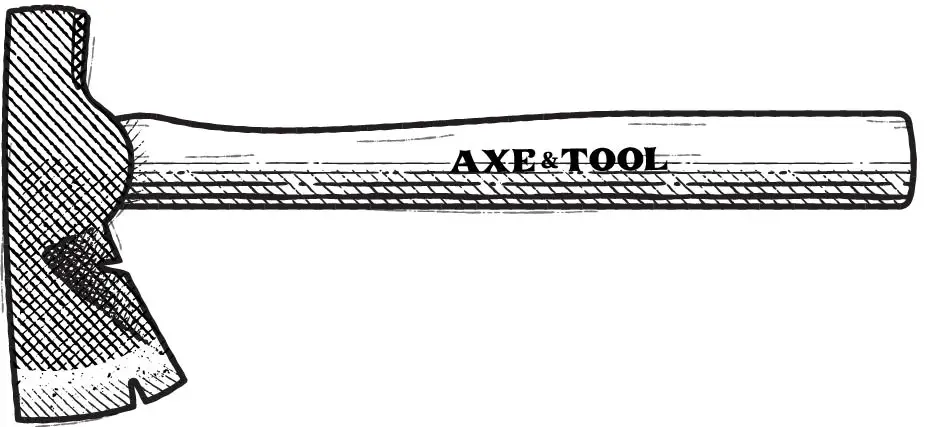
Barrel hatchets are for packing and unpacking goods shipped in barrels. These small hatchets have a curved head shape or a tilted hammer on the back to account for the curve of a barrel when hammering the hoops (metal rings) on or off. The blade is thin for prying with one to three nail slots.
The curved shape of the head or angled hammer is key for opening the barrels. The user needs to be able to hammer the hoops while working around the curved middle of the barrel. This makes it distinct from similar “Box” or “Produce” hatchets.
See the full article on barrel, packers, and produce hatchets for more details and photos.
Bearded Axe

A bearded axe is characterized by a long blade that drops down below the rest of the head, forming what’s known as a beard. The extended cutting edge creates a gap behind the blade, allowing users to use various grips, and to hold behind the blade for precise tasks.
Not all axes have beards, even if they swoop down. The square(ish) or round gap created by the back of the blade running parallel with the handle (or close to it) defines a beard.
Beards can be found on many types of axes and are a more common feature of European and Scandinavian designs.
Belt Axe
AKA: Trade Axe | Bag Axe

A belt axe is a small, portable axe historically carried in the wilderness on a person’s belt for easy access. The handle was often straight to slide in and out easily, and the blade would flare down to hook the belt and keep it in place.
Different types of belt axes have been used for centuries all around the world, so there are many different designs. They could be fixed hatchets, or use slip-fit handles like tomahawks or North American trade axes.
Bench Axe
AKA: Hewing Hatchet | Broad Hatchet | Side Axe

A bench axe is a large hatchet with a wide blade used for quick wood removal and rough shaping by woodworkers. The blades are often single-beveled so they can create flat surfaces (hewing).
Historically, bench axes could have short hammer-like handles up to 21″ curved handles that could be used one or two-handed for hewing larger timber.
Blazing Axe

A blazing axe is a hatchet or small axe used to slash patches of bark off trees to mark (blaze) them. Blazes might mark a trail to a work camp or logging site or might be used to designate trees for removal.
Small double-bit axes called “Saddle Cruisers” were often used for this job. However, some chose to use a more specialized “Marking Axe“.
Boarding Axe

Boarding axes were used by sailors during naval combat from the 17th to 19th century. The heads had both a broad blade and a spike on the back, hung on a short maneuverable handle. They were used as versatile weapons, to fight, cut ropes, and break through doors and barriers.
The balance of capability and portability was key, as this had to be carried across ropes and planks between swaying ships on the ocean and in tight quarters below decks during combat.
Boxing Axe
AKA: Turpentine Axe

Boxing Axes were a key tool of the turpentine industry. Initially used to chip out cavities or “boxes” out of large pine trees to collect resin. These axes had long, heavy, and thin heads for driving deep into the pitch-filled wood. The heads were around 14″ long and often 7 lbs or heavier.
For a more thorough explanation check out the post by Exploring Axe History.
Box Hatchet
AKA: Crate Hatchet | Packer’s Hatchet | Produce Hatchet
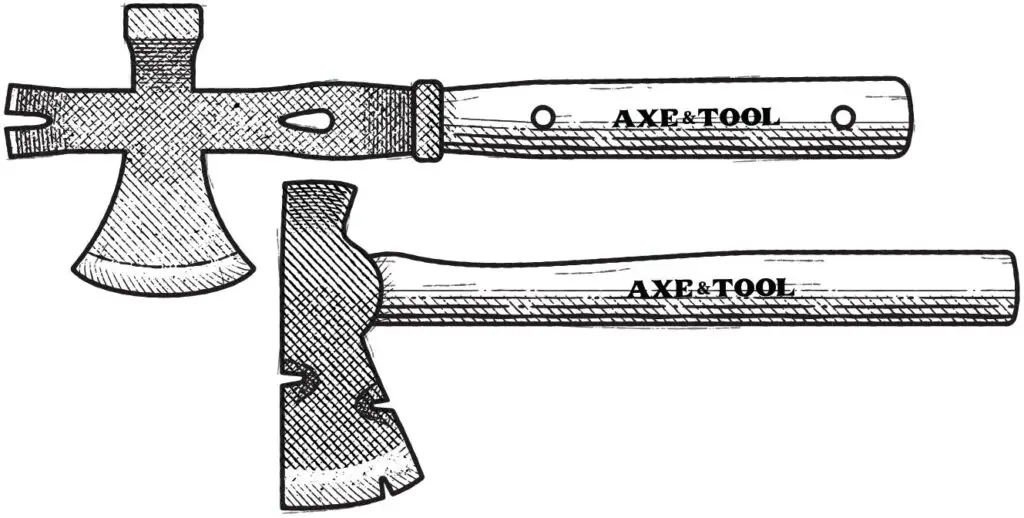
Box hatchets are used to open and reseal wooden crates that store products or materials. They are small hatchets that combine a sharp blade for chopping and prying, nail pullers, and a hammer. Some all-steel designs also include a pry-bar end.
Historically, the more common design included a long thing blade that could both chop and pry, and there could be up to 3 nail slots in the blade (top, bottom, and in bit itself).
However, there is an all-steel design with the pry-bar top that was introduced by Bridgeport in the early 1900s as well, which persists to this day. See the modern version.
Boy’s Axe
Head Weight: 2.25lbs | Length: 28″

Boy’s axe is a broad term for a mid-size axe, and despite the name they have always been popular as a work axe for adults. They are typically 28″ long with a 2.25lb head but length and weight can vary. These axes are best for chopping and splitting trees under 12 inches.
The confusing thing about this size of axe is that many types and names overlap. “Boys Axe” refers to the general size, but terms like Camp Axe, Pulpwood Axe, and Forest Axe, are often used interchangeably. Although technically those are more specialized axe types that all fall under the bucket of “Boys axe”.
Branding Axe

Branding axes could be small to full-size axes modified by logging companies by adding a branding stamp to the back. The stamp was hammered into the end grain of logs being sent downriver for identification when they reached their destination.
There are very similar marking axes that also have stamps on the back, but these tend to be hatchets or small axes.
Brick Cleaning Axe
AKA: Brick Dressing Axe

A brick cleaning axe is a mason tool used for scraping old mortar of used bricks. It is a double-bit hatchet with wide thin blades and relatively flat cutting edges. These blades come to a point but are not truly sharpened.
Bridge Builders Axe

A bridge builder’s axe is similar to a maul with a heavy hardened poll for hammering bridge components into place, but the blade is thin and squared for rough shaping large timber, rather than a wedge for splitting.
Broadaxe
AKA: Hewing Axe | Squaring Axe

Broadaxes (also called hewing axes) have a heavy wide blade historically used for squaring timber (hewing) for framing and construction. They often have a single beveled edge which can help produce a smooth flat surface. The handles are straight but canted away from the head for ergonomics.
Different types of broad axes might be used for rough hewing or final shaping and smoothing, and the blades can be single or double-beveled.
Broad Hatchet
AKA: Hewing Hatchet | Bench Axe | Side Axe

Broad hatchets have a heavy head and wide blade for quick wood removal and rough shaping by woodworkers. The blades are often single-beveled to help shape flat surfaces (hewing). They are also known as hewing hatchets or bench axes.
Broad hatchets have been around for centuries and were commonly used until the mid-1900s. The heads were commonly around 2 lbs, but makers offered different sizes depending on the customer’s needs (you can often find older heads stamped with a size number).
These axes could have short hammer-like handles up to 21″ curved handles that could be used one or two-handed for hewing larger timber.
Brush Hook
AKA: Billhook | Brush Axe

A brush hook, also known as a billhook or a brush axe, is used for clearing vegetation, thick brush, and small branches. It has a curved hook-shaped blade with a sharp inner edge, hung on a full-length axe handle.
Brush Axe (Swedish)

A short version of a brush axe with a straight thin blade, held within a C-shaped holder. The handle is attached to a socket in the head. They are used for clearing brush and small branches.
Bus Axe
AKA: Small Fire Axe
Head Weight: 2-2.75lbs | Length: 24-28″

A bus axe is a small fire axe with a pick that was mounted on a bus or other public transportation vehicle for emergency purposes. This axe is used to break windows or doors in case of emergencies such as fires, accidents, or other situations where passengers need to evacuate quickly.
Bushcraft Axe

A bushcraft axe is a small axe or hatchet designed to perform various tasks such as chopping, splitting, carving, and shaping wood for shelter construction or campfire preparation in the wilderness. They may also incorporate features such as a hammerhead. These axes are compact for easy portability as they may be carried long distances on foot.
Butcher’s Axe
AKA: Meat Splitting Axe
Head Weight: 4-6 lbs | Length: 24-30″

A butcher’s axe was a specialized broadaxe used to slash a dressed carcass into manageable sections (like splitting into sides). The heavy head could cut through tissue, bone, and cartilage. A hammer poll on the back could be struck to help force the blade through or be used to break apart bones/joints.
Butcher’s Hatchet
AKA: Kitchen Axe
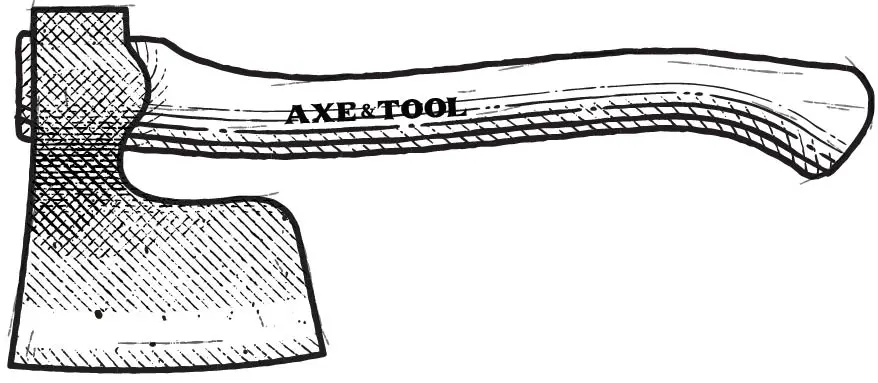
A Butcher’s hatchet is a large hatchet with a wide blade used instead of a cleaver for splitting up large pieces of meat, slashing through cartilage and soft bones.
Butcher Pole Axe
AKA: Slaughtering Axe | Killing Axe

A Butcher Pole axe or slaughtering axe has a small blade on the front and a long metal rod or tube on the back similar to a hole punch. The pole is used for punching through the animal’s skull. A rod would then be inserted into the brain to guarantee death.
C
Camp Axe

A camp axe is a broad term for a small-to-mid-size axe used around camp, capable of clearing small trees on the site, camp craft, and fire making. They are more robust than a hatchet but often smaller than a standard work axe or boy’s axe. They could have a 1.5-2.25lb head on a 19-24” handle.
Historically these axes were for daily tasks at large encampments or work camps where men were often living for long periods. But these days they are used for more robust outback camping, bushcraft, or even car camping.
Carpenter’s Axe

A carpenter’s axe is used for rough shaping wood during carpentry. They typically have a wide blade with a fine edge. While some companies sell specific carpenter’s axes the term can also refer more broadly to tools like half-hatchets, broad hatchets, or any other hatchet used in carpentry.
Carving Axe
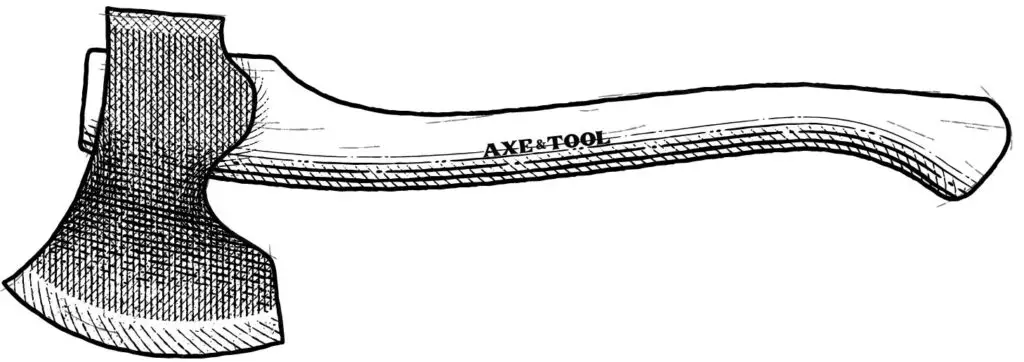
Carving axes have specialized heads and handles that are designed to give the user maximum control for bulk wood removal, quick shaping, and fine-detailed carving. Larger carving axes often have heads with long and radiused bits with upswept toes, a sharp flat-ground edge, and usually a heavier weight of around 2 lbs.
However, many different styles of hatchets can be used or modified for carving and smaller carving axes often have short flatter blades which are easier to use precisely and learn on.
Chainsaw Axe (Single-bit)

A chainsaw axe is a lightweight mid-size axe used in conjunction with a chainsaw when felling. They have a broad thin blade for quickly clearing branches and chopping small trees or brush out of the way, and a wide flat poll for hammering felling wedges.
This is similar to a faller’s axe or “wedge banger“, but typically lighter weight with a greater focus on limbing than hammering wedges.
Chainsaw Axe (Double-bit)
AKA: Undercutter

“Chainsaw axe” was another term for an Undercutter axe. These were used by loggers on the West Coast from the 1930s to the early 1950s who were felling trees with early chainsaws. They were designed with a long blade for chopping deep and a narrow chisel bit on the back for clearing chips between chainsaw cuts.
There is a little more info in the Undercutter section.
Chopping Axe
AKA: Felling Axe

A chopping axe or felling axe is designed to chop into the side of a tree or log. They can chop down a tree (felling it), or buck a log once on the ground by cutting through the wood fibers with a thin sharp blade. The term was often used for a single-bit axe, with a 3-4lb head and a 30-36″ handle.
However, there are many different shapes and patterns of chopping axe based on the region they were made and the types of trees primarily being chopped down. This includes single-bit and double-bit axes.
Depending on the pattern, felling axes have long been used as general “work” axes, used to fell, chop, and split wood.
Claw Hatchet

A claw hatchet is similar to other construction hatchets, but it has the claw of a hammer on the back of the head instead of the hardened face. It is used for pulling nails or prying materials apart during carpentry, woodworking, and general construction tasks where both cutting and nail removal are required. The claw is compact making it useful in tight spaces.
Clog Maker’s Axe
AKA: Sabot Maker’s Axe
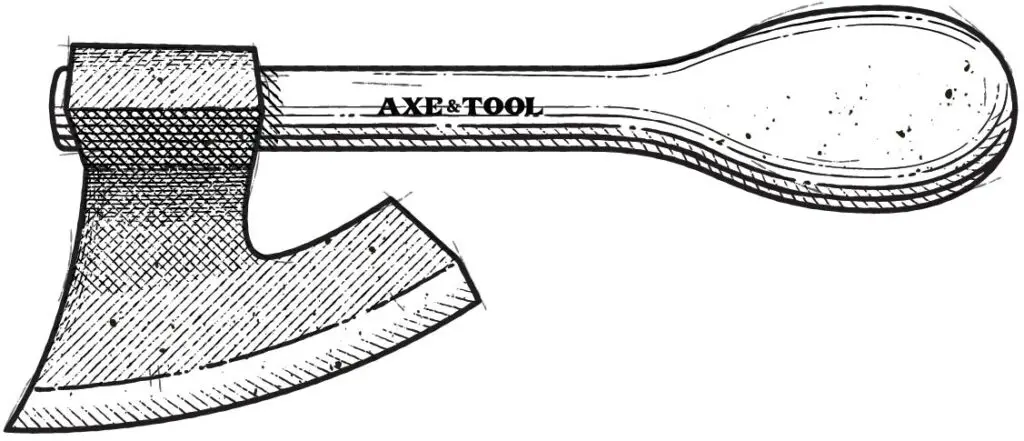
A Clog Maker’s axe used to shape wooden shoes. It has a wide curved blade that sweeps back and a short handle with a distinct bulbous end that acts as a counterweight to the blade and helps balance the axe for frequent repeated cuts.
Coach Makers Axe

A coachmaker’s axe is a specialized woodworking tool traditionally used by coachmakers for shaping and smoothing wooden parts in the construction of a carriage or coach. It has a wide thin bearded blade and a short handle, allowing for precise control and fine detail work.
Coal Mine Track Axe
AKA: Coal Mine Deputies Axe | Collier’s Axe | Collie Axe

A Coal Miner’s Track Axe had a long hardened poll or “maul head” for adjusting the timber under the track and driving the spikes to hold it down. The extended poll allowed the user to hammer the spike over a section of track without damaging or breaking the handle.
These axes were compact for use underground often 24″ or under, and were often cut down further. This is a distinctly different axe than the more common “miner’s axe” although they served a similar purpose.
Coal Miner’s Track Hatchet
AKA: Collier’s Hatchet | Collie Hatchet

A Coal Miner’s Track Hatchet is a smaller version of a track axe. with a long hardened poll adjusting the timber under the track and driving the spikes that held them down. The extended poll allowed the user to hammer the spike over a section of track without damaging or breaking the handle.
Collared Axe

A collared axe has a steel tube dropping down from the bottom of the head, extending the eye. This creates more hold with the handle and forms a protective collar around the top of the handle. The design was popular in Scandinavia and parts of Europe, but can be found in North American designs as well.
Constructor’s Axe
AKA: Demolition Axe
Head Weight: 4-5lbs | Length: 36″

A heavy axe with a hardened poll (similar to a maul) able to be used for both chopping and hammering, marketed for construction or demolition sites. These axes often used a 4-5 lb rafting pattern head on a 36″ inch handle.
Cooper’s Axe

A cooper’s axe is used by a barrel maker (cooper) to rough cut and shape the wooden slats (lists) that are used to form the body of the barrel. This process is called listing. It can also be used to shape the headpieces.
Cooper’s axes are often misidentified as hewing hatchets, as they share some similarities. However, Cooper’s axes have large thin blades – often 9-12 inches long, with short offset handles. To save the cooper’s knuckles from scraping on the wood, both the eye hole is angled as well as the handle will be bent.
Cruiser
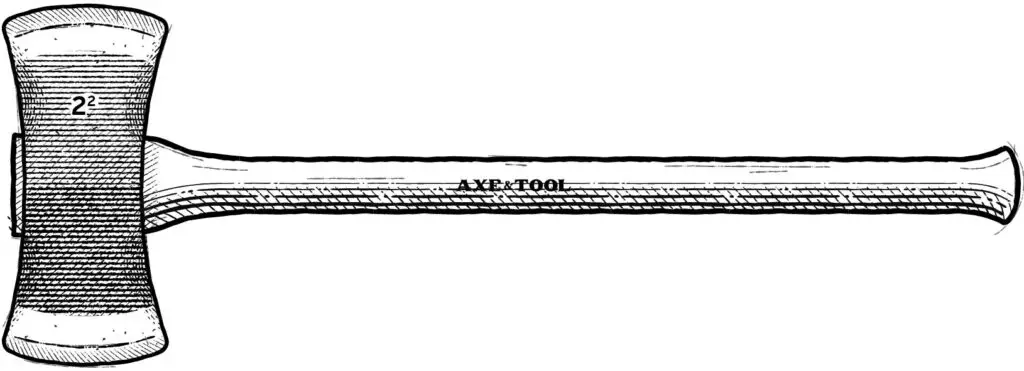
A “cruiser axe” is a compact double-bit axe that was historically used by Timber Cruisers (later Forest Engineers) to blaze a trail and mark trees while they evaluated the potential lumber yield on a plot of land. The most common size is 28″ with a 2.5lb head, but they can be smaller.
A 28” handle and 2.5 lbs became the “standard” definition of a cruiser as they were by far the most widely produced model of the cruiser, and many companies continued to sell them into the 1970s or 80s, long after they were needed for their intended role.
See the full Cruiser article for more details and photos.
Cupping Axe
AKA: Apron Axe | Turpentine Broad Axe

A turpentine broad axe or “cupping axe” is distinct as it has a concave blade shape that curves inward. They were used in the early 1900s to cut grooves into pine trees for metal gutters to collect the pitch and resin. This was a more sustainable method of turpentine production than the box method.
For a more thorough explanation check out the post by Exploring Axe History.
D
Double-Bit Axe

A double-bit axe has a head with two cutting edges (bits), one on each side. Two cutting edges provide extended use between sharpening or different edge profiles. One edge may be thin for aggressive chopping, while the other is stronger for chopping knots and roots.
The two bits may be identical or different shapes depending on the intended use. Technically, axes like Pulaski’s and Fireman’s axes (with a spike) are double-bit axes.
Even for axes with two identical blades, there are distinct and specialized types of double-bit axes, most of which were born from the lumber industry. Examples: Fallers, Swampers, and Crusiers.
F
Faller’s Axe
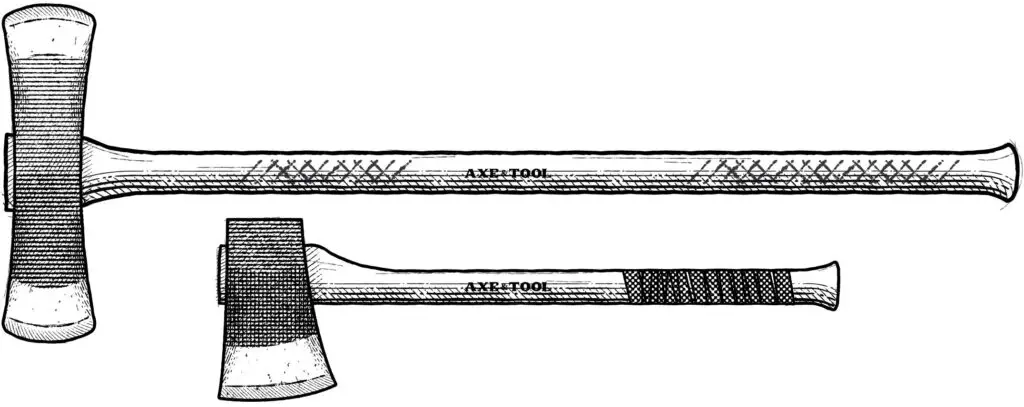
Two distinct axes share the name “Faller’s Axe”, both are used for the same purpose – but a faller’s needs changed over time with the invention of the chainsaw.
Historically a faller’s axe was a double-bit axe with a long narrow head, used to chop down the large old-growth trees of the West Coast. But, the modern faller’s axe is a heavy single-bit axe, with a flat poll and short straight handle used to fall trees by hammer wedges into a chainsaw cut.
The name came from logging companies that would have teams of “fallers” whose only job was to chop down trees. Other crews would come swamp, buck, or move the logs on the ground.
Felling Axe
AKA: Chopping Axe

A felling axe (chopping axe) is used for chopping down trees, or “felling” them. They typically have heads with thin sharp blades for making deep cuts through the wood fibers of a tree, and 28-36″ curved handles for better balance when swinging horizontally.
However, there are many different shapes and patterns of felling axe based on the region they were made and the types of trees primarily being chopped down. And, the size of a felling axe can range based on the size of the tree to be felled.
Depending on the pattern, felling axes have long been used as general “work” axes, used to fell, chop, and split wood.
Fire Axe (Pick)
Head Weight: 3-8lbs | Length: 28-36″

The iconic fire axe is a large axe with a chopping blade at the front and a long spike at the back. Both the cutting blade and the spike are used to break through barriers and create openings for fighting fires.
Fire axes can come in all sizes (see bus axe), but they often have a heavy 4-6lb head to generate more force for punching through obstacles. Some even go as high as 8lbs.
Fire Axe (Flat-head)
Head Weight: 4-6lbs | Length: 28-32″

Flat-head (forcible entry) fire axes are used for breaking through sealed doors. Like other fire axes the blade can be used for chopping into the doors or frames, but the flat back of the head can be used for knocking off door knobs and hammering on halligan entry bars “irons”.
These flat-head axes often have special grooves in the blade so they can be fitted and stored with the Halligan tool. These axes are also usually heavier with a 4-6lb head to maximize impact.
Fireman’s Hatchet

A Fireman’s hatchet is a small pick-head fire axe that can be used one or two-handed to break through barriers and make openings when fighting fires in tight spaces.
Flooring Hatchet
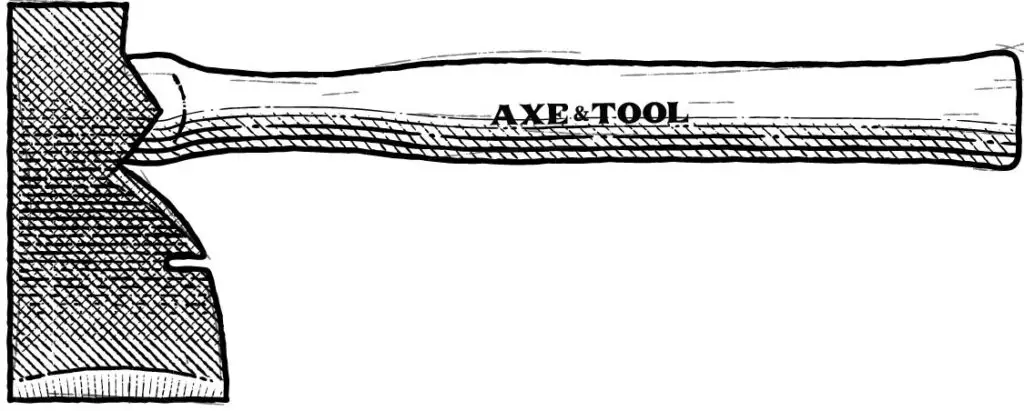
A flooring hatchet is similar to a half-hatchet, but the blade is offset to the side and it has a single bevel cutting edge, so it can lay flat on the floor. The poll is also squared (instead of a classic hammerhead) forming 90° angles with both the top and side of the head.
Forest Axes
Head Weight: 1.5 – 2lbs | Length: 23-26″

A forest axe is a lightweight mid-sized axe for light forest and trail maintenance. Designed to be carried and used without the assistance of chainsaws and capable of limbing, felling small trees, or bucking fallen logs. They are typically 23-26” long with a 1.5 – 2.25 lb head.
Freighters Axe
Head Weight: 2.75lbs | Length: 28-32″

Freighters axes were mid-size single-bit axes used by freight carriers. They were slightly larger than a boys axe with a 28″-32″ handle and 2.75 lb head.
G
Goosewing Axe

The goosewing axe was a common European design (German specifically) of a broad axe. The blade sweeps up from the handle at an angle, resembling the wing of a goose, and the canted handle fits into a socket, rather than going through an eye.
The Gooswing design was primarily used in hewing axes and hatchets and became common early on in North America as German settlers arrived. But, it was also used for more specialized tools like Cooper’s axes.
H
Half-Hatchet
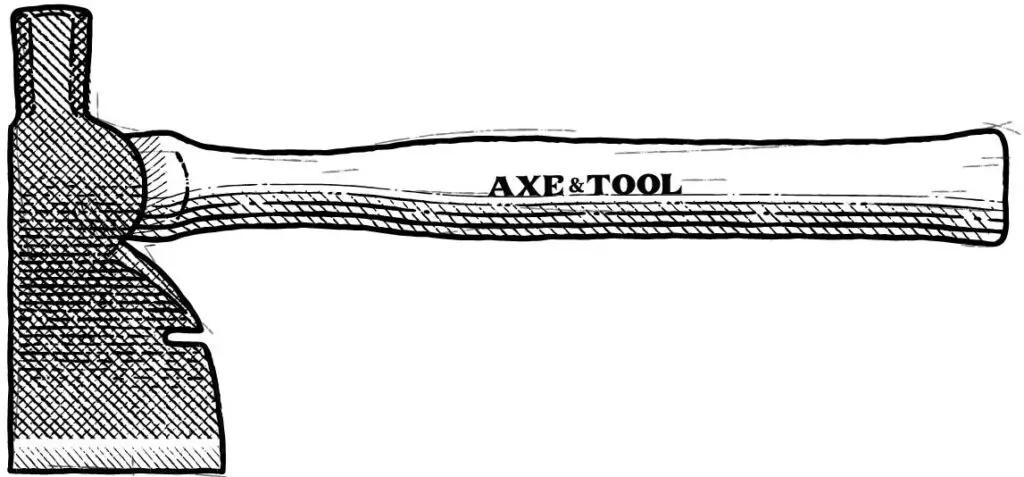
A Half-hatchet is used in construction with a wider straight-edge blade cutting and shaping, and a hammerhead on the back. They have a straight hammer-like handle and the head is flat-topped to allow hammering in tight spaces. Some also have nail pullers in the bottom of the blade.
Hammer Poll Axe
AKA: Killing Axe

The Hammer poll axe is both a category of axe and a specific model.
The term applies broadly as a category to any axe with a hardened hammer on the back of the head (the poll).
The named “Hammer Poll axe” model has a chopping head, similar to a Dayton pattern with an octagonal hammerhead on the back (shown above). Originally marketed in the early 1900s to loggers as able to both chop and hammer wedges, its popularity quickly grew as a general work/farm axe, and as a killing axe.
Hand Hatchet
AKA: Compact Hatchet | Pack Hatchet | Ultralight Hatchet

A hand hatchet is a compact hatchet designed to be carried in a pack during outdoor activities where space and weight are limited and maneuverability is key (like backpacking). They combine a full-size 1lb hatchet head on a short 9-10″ handle.
These hatchets are often mislabeled as Mini Hatchets (which is understandable), but that is a different style of hatchet.
Many folks think even an axe like this is too heavy to bring backpacking, but I always do – In my opinion, it could save your life. See “Why you should bring an axe backpacking“.
Hatchet

A hatchet is a broad term for any one-handed axe, but a more focused meaning has shifted over time.
Historically, the term hatchet was used primarily for woodworking and construction tools that often had a blade on one side of the head, and a hammerhead on the other. Tools like roofing hatchets, lathing hatchets, flooring hatches, broad hatchets, etc.
Today, the term hatchet does still apply to the tools above, but it’s much more likely to be about outdoor hatchets, used for chopping wood and splitting kindling. They will have a handle 16″ or shorter and a head between 1-2 lbs. These historically were called “hunter’s axes”, “sportsman axes” or “axe-head hatchets”.
Hewing Axe
AKA: Broadaxe | Squaring Axe

Hewing axes (also called broadaxes) have a heavy wide blade historically used for squaring timber (hewing) for framing and construction. They often have a single beveled edge which can help produce a smooth flat surface. The handles are straight but canted away from the head for ergonomics.
Different types of broad axes might be used for rough hewing or final shaping and smoothing, and the blades can be single or double-beveled.
Hewing Hatchet
AKA: Broad Hatchet | Bench Axe | Side Axe

Hewing hatchets have a heavy head and wide blades are used to shape and flatten the sides of a log or piece of wood. The blades are often offset with a single bevel to make consistent flattening cuts, but they can be double-beveled as well.
High-Rigger’s Axe
AKA: High Topper’s Axe
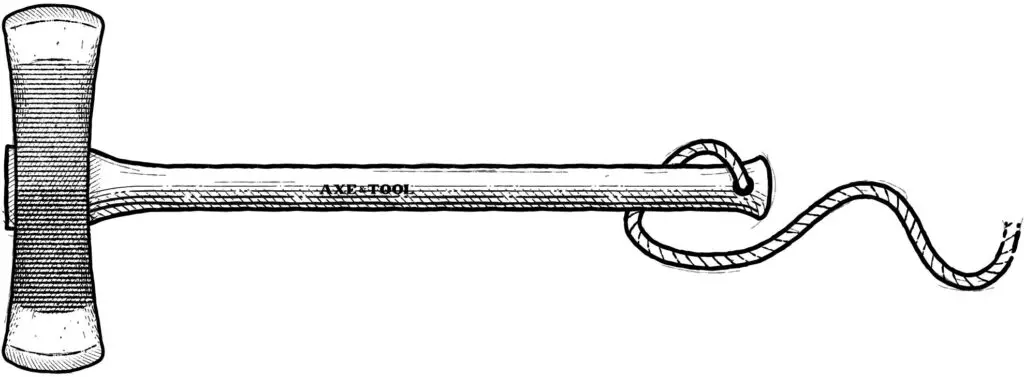
A High-Rigger’s or Topper’s axe consisted of a full-size double-bit axe head (usually a puget-sound) on a compact 24″ handle. The handle had a large hole in the grip, for a rope so the axe could hang from a high-riggers belt as they climbed a spar tree.
High-riggers would climb the tallest trees, hundreds of feet in the air. They used the axe to remove branches and eventually, the top of the tree so pully systems could be attached for moving timber while logging.
Check out this eyewitness account of the feat from the early 1920s: A Mere Outline Against The Blue Sky.
House Axe
AKA: Small Axe

A house axe was a small 16-20″ long axe with a 1.5-2lb head historically kept around the house for everyday chores. This could include splitting wood and kindling, gardening, and processing smaller livestock. They were sized to be versatile and managable by all members of the family.
Hunter’s Axe
AKA: Sportsman’s Axe | Axe Head Hatchet | Skinning Axe
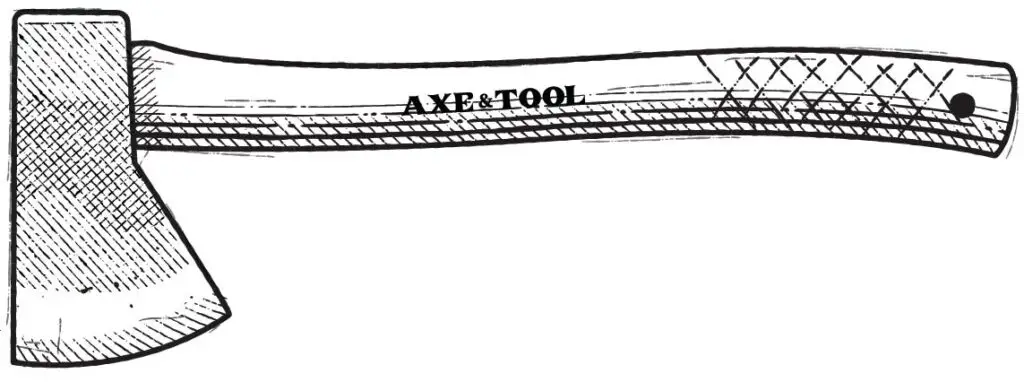
A Hunter’s axe is a historical name for a hatchet or small axe used in the outdoors. Typically with a 1.25 – 2 lb head on a 14-16″ handle. However, the term evolved to mean hatchets and axes with features like a textured grip, or rounded poll and thin blade for skinning and field dressing game.
I
Ice Axe (climbing)
AKA: Climbing Axe

An ice axe is a specialized tool used in mountaineering and ice climbing. It typically consists of a shaft, a pick, and an adze or a hammer on the opposite side of the pick. The shaft is usually made of metal or a combination of materials like aluminum or carbon fiber.
Ice Axe (house/harvesting)

Ice axes had a long, narrow blade with a curved edge used for breaking through ice for harvesting. They often had a hook on the back to help move the blocks of cut ice. There were many sizes of ice axe from large two-handed axes, down to hatchets.
J
Joiner’s Axe

A Joiner’s axe is a woodworking axe used to help shape joints and fittings that connect different pieces of wood together. It will have a wide thin blade for fine shaping, with a head shape that allows holding near the head for more control.
The term Joiner’s axe has become largely interchangeable with a carpenter’s axe, but there has historically been a wider range of heavier and less precise carpenter axes.
K
Killing Axe
AKA: Butcher Pole Axe | Slaughtering Axe | Hammer Poll Axe

A Killing axe is a broad term for different types of axes used in the slaughtering of animals. There are two main types that are used as a killing axe the “butcher pole axe” and the “hammer poll axe”.
Butcher pole axes have a small blade on the front and a long metal rod or tube on the back similar to a hole punch. They were used to punch through the skull of livestock before A rod would then be inserted into the brain to guarantee death.
Hammer poll axes were a versatile chopping pattern, with a hammer sticking out the back. They could do work all over the farm, as well as being used to stun livestock before a sticking knife was used to make the kill.
Kitchen Axe

A Kitchen Axe or hatchet is a small axe used instead of a cleaver for splitting up large pieces of meat, slashing through cartilage and soft bones, as well as hard vegetables (like squash). The side of the axe head can also be used for crushing foods during preparation.
There is no specific head shape for a kitchen hatchet, many are custom-made with hatchet heads designed for other purposes.
L
Lathing Hatchet
AKA: Drywall Hatchet | Drywall Hammer

A lathing hatchet or drywall hatchet has a thin flat blade and a hammerhead used for trimming and nailing a base of wooden laths for plastering walls. The hammerhead often has cross-hatch grooves intended to prevent slipping when hitting small nails.
Lineman’s Axe
AKA: Bell Systems Axes

A lineman’s axe was a heavy broad hatchet used by phone company linemen to maintain utility poles. They typically had a square hole on the blade that was used to tighten or loosen bolts in a cross-arm.
Lugged-axe

A lugged axe has metal ears (lugs) that drop down on either side of the eye to extend the amount of grip the axe head can have on the handle to reduce the chance of loosening. Lugs can be pointed or rounded, and have been used on countless types and models of axe for centuries.
The common patterns seen with lugs are Jersey and Kentucky pattern chopping/felling axes. Also, the popular Swedish forest axes (Gransfors Bruk & Hults Bruk).
M
Marking Axe

A marking axe is a compact axe with a wide blade for removing tree bark and a stamp on the back for marking the exposed wood. Forest Service workers and loggers used them to designate trees for removal.
The compact size (16-24″) made them portable to be carried through the forest.
Masting Axe
AKA: Ship Carpenter’s Axe | Shipwright’s axe
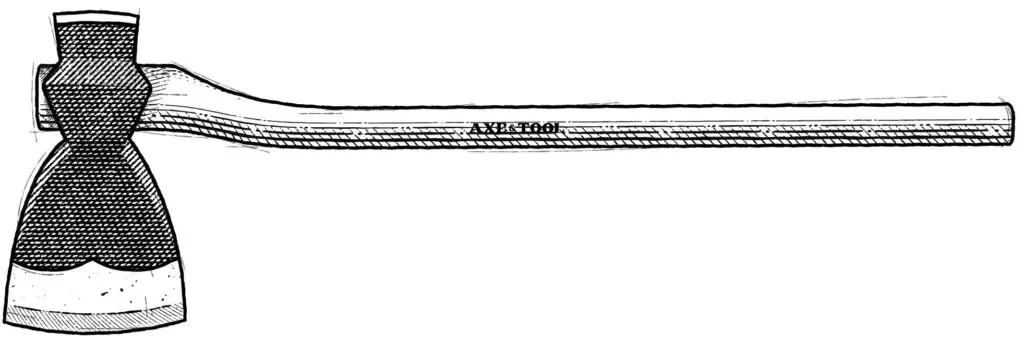
A masting axe is a specialized broadaxe used by shipbuilders. It is designed for shaping and smoothing wooden components in shipbuilding. They have narrower and longer blades than most other hewing axes to aid in some of the more complex shapes needed for shipbuilding.
There is a range of sizes and styles, but the handles were anywhere from 24″-30″ long, and the heads were 4-6lbs.
Maul

A Maul is a heavy hand tool designed for splitting wood similar to an axe. They have a heavy 6-8lb head with a blade that can force its way through tough wood. The back of the head is hardened to be used for hammering splitting wedges.
Mauls and splitting axes are very similar, but they are different. Check out my complete comparison of splitting axes vs mauls.
Meat Splitting Axe
AKA: Butcher’s Axe
Head Weight: 5-6 lbs | Length: 24-30″

A meat splitting axe was a specialized broadaxe used to slash a dressed carcass into manageable sections (like splitting into sides). The heavy head could cut through tissue, bone, and cartilage. A hammer poll on the back could be struck to help force the blade through or be used to break apart bones/joints.
Meat Tenderizing Hatchet

A meat tenderizing hatchet combines a mallet with sharp points used to even out and tenderize tough cuts of meat, with a hatchet blade that can be used to cut the meat into portions.
Miner’s Axe

A Miner’s axe was used for fitting timber supports within the confined spaces of a mine. They have a full-size 3-4 lb chopping axe head (usually a Dayton pattern) on a short 19-20″ straight handle. The Dayton pattern was used because the wider flay poll was good for hitting the timber into place.
Miner’s axes are still available today, although not for the mines. Now they are often used as a wedge-banging falling axe or for clearing brush, and roots.
Mini Hatchet
AKA: Super Sportsman
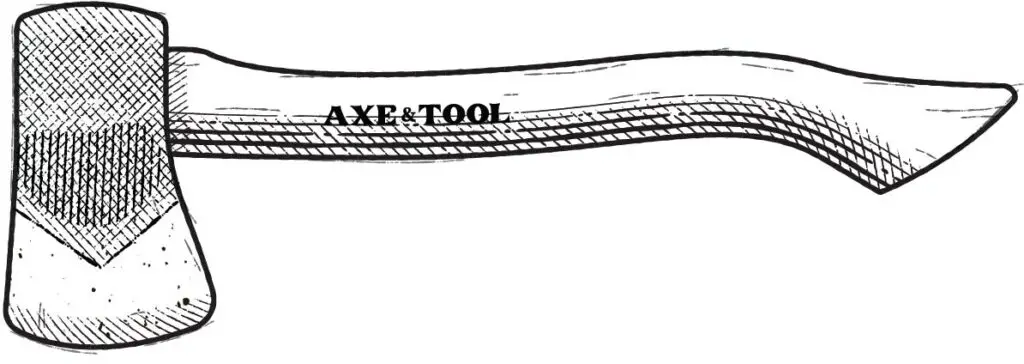
A mini hatchet is a lightweight hatchet designed to be carried during outdoor activities where space and weight are limited. They have a small 0.5-0.75 lb head on a 10-11″ handle which gives them similar proportions to other hatchets – just mini. Forestry workers also used them as sounding axes.
The distinct small head design sets axes apart from the other (more popular) compact axes – hand hatchets. Which are much more common today.
Some Mini-hatchets like the Vaughan Super-Sportsman often get mistaken for salesman samples because the proportions are so similar to the larger axes.
Mortise axe
AKA: Post Hole Axe
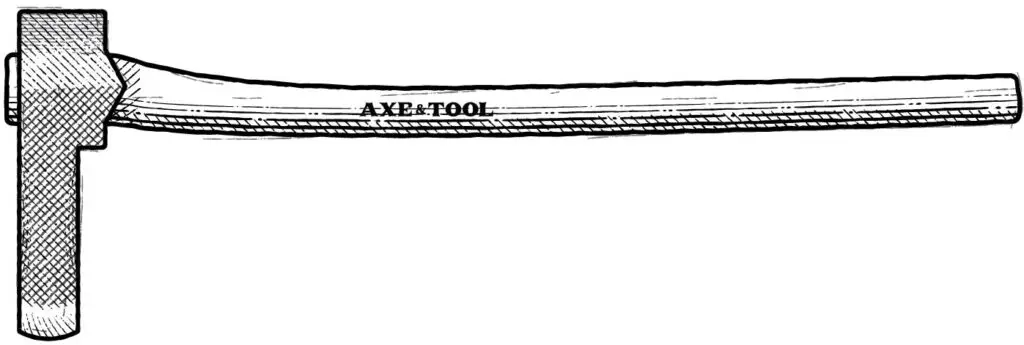
A mortise axe is used for cutting a rectangular hole (a mortise) in timber which can receive the tongue (tenon) on another piece to join them together. The axe can replace the need for a chisel when hewing sills & notches in joints.
N
Nessmuk Axe
AKA: Saddle Cruiser

A Nessmuk axe is a small double-bit hatchet, typically with a 1-1.5lb head on a 16″ handle (also known as a Saddle Cruiser). In 1884 the book “Woodcraft” popularized this type of axe for outdoor activities, and the name comes from the book’s author George W. Sears wrote under the pen name “Nessmuk”.
Nessmuk is considered a grandfather of camping and bushcraft for recreation, and “Woodcraft” remains in publication 140 years later.
These hatchets weren’t originally made for recreation. Find out more in the full Cruiser article with more details and photos.
O
Ono
AKA: Japanese Axe

In Japanese, the word for axe is ‘Ono’. The Japanese traditionally have unique designs for axes and hatchets compared to other regions, but they were used for all the same roles you would find in North America and Europe.
Ono can be used to describe most axes, hatchets, and similar tools.
P
Pickaroon

A pickaroon isn’t really an axe – but it’s close enough to include.
A pickaroon is a tool designed to move and handle logs. It consists of a pointed metal hook mounted on a wooden handle. The point of the pick penetrates the wood and is used to pull, turn, lift, and drag the timber.
Pickaroons are commonly used in logging and other forestry activities to move logs around, especially when they need to be separated, sorted or lifted onto a sawhorse or a skid.
Pipe Hawk

A pipe hawk is a specialized tomahawk where the back of the head is the bowl of a pipe, and the handle acts as the shank or smoke channel. They were a ceremonial tool used during diplomatic meetings between some indigenous people and settlers in North America.
Pulaski Axe

The Pulaski is a specialized axe designed for fighting forest fires and making firebreaks. The two-sided head combines a chopping axe with an adze hoe (mattock) capable of digging earth and cutting through roots. It was created by US Forest Service Ranger Ed Pulaski following a large fire in 1910.
A Pulaski has a 3.5-4lb head that fits on a straight 36” handle with a double-bit eye. The hoe on the back of the Pulaski has a strong, flat cutting edge to allow it to break through ground debris and cut through roots. I have a full write-up with more details and information on the exciting invention of the Pulaski tool.
See the full article on Pulaski for more details, history, and photos.
Pulpwood Axe

A pulpwood axe is a mid-sized axe designed for removing limbs and felling trees used in making pulp for the paper industry. The axes have heads under 3 lbs with wide thin blades for chopping through trees 6-9” in diameter. commonly used in the pulpwood industry.
Pulpwood “Tommy” Axe

A unique double-bit axe with a narrow chopping bit and a long pick for manipulating pulpwood timber at the mill. This specialized version of an axearoon seems to have had limited use and was possibly custom-made for a specific mill/region.
This axe resembles an undercutter axe, but the pick is quite distinct. See a cool example here.
Post Hole Axe
AKA: Mortise Axe

A mortise axe is used for cutting a rectangular hole (a mortise) in timber which can receive the tongue (tenon) on another piece to join them together. The axe can replace the need for a chisel when hewing sills & notches in joints.
Produce Hatchet
AKA: Packer’s Hatchet | Box Hatchet

Produce or Packer’s hatchets were used by merchants, warehouse workers, and factories to open and reseal wooden boxes that stored products or materials. They are small hatchets that combine a long thin blade for chopping and prying, nail-pulling notches, and a hammer.
Different axe makers used a range of terms for these little hatchets, and their features could vary slightly. These were also known as box hatchets, but there was also a more robust all-steel design that used that name.
See the full article on barrel, packers, and produce hatchets for more details and photos.
R
Rafting Axe
Head Weight: 4-5lbs | Length: 28″

A rafting axe was used by the loggers who assembled timber into large floating “rafts” for sending down the river to the mill. The axe had a straight 28″ handle and a heavy 4-5 lb head with a wide hardened poll for hammering metal chain loops (log dogs) into the timber for chaining them together.
Rafting pattern axe heads are still commonly found today, but most were not actually made for rafting axes. The pattern was also marketed as a splitting axe (mauling pattern) and construction/demolition axe.
Rigger’s Axe

A Rigger’s Axe is a heavy, long-handled version of a half-hatchet or carpenter’s axe. The extra weight and length make it a popular tool with framers due to its efficiency in driving nails and shaping lumber. The name comes from its original purpose building wooden oil derricks (oil rigs).
A rigger’s axe typically has around a 1.75 lb head with a 17-19″ handle. A standard half-hatchet or carpenter’s axe is 14″-16″ with a lighter 1.25-1.5lb head.
These axes are still available today from Vaughan and Estwing.
Roofing Hatchet
AKA: Shingling hatchet

A roofing hatchet is used for removing, installing, or repairing shingles. They have a thin, square blade for cutting and shaping shingles, a hammer for driving nails, and often a notch for removing nails. In modern hatchets, the blade may also have a gauge for spacing tiles and cuts.
Vintage roofing hatchets often had a round head and blade shape.
Rounding Axe

A rounding axe was a heavy axe used in Europe for removing the buttress at the base of trees to be felled. This was particularly important in the UK, as an island nation lumber was a limited resource. Trees would be felled at ground level to get the maximum amount of usable timber.
These axes were swung down around the perimeter of the tree, and have a distinct head shape with a long hooked blade shape and enlarged eye. These heads were typically 5-7 lbs.
S
Saddle Cruiser
AKA: Nessmuk Axe

A Saddle-Cruiser is a small double-bit hatchet, typically with a 1-1.5lb head on a 16″-19″ handle. They could be attached to the saddle and used one-handed on horseback by cruisers or forest engineers to blaze a trail and mark trees while they evaluated the potential lumber yield on a plot of land.
These axes were also popularized for camping and outdoor activities in the book “Woodcraft” published in 1884 by George W. Sears who wrote under the pen name “Nessmuk”. Sears is seen as the grandfather of bushcraft and conservation, and these axes are often referred to as “Nessmuk Axes” by this crowd.
See the full Cruiser article for more details and photos.
Salesman’s Sample Axe

For decades traveling salesmen would go to hardware companies to try and get their company’s axes stocked on shelves. They would often carry small versions of their axes to show off their wares. They were often made of aluminum or wood to make them lighter and easier to lug around.
These are still found by collectors, but certain mini-hatchets or sounding axes often also get mistaken for Salesman samples.
Wood or aluminum versions of full-size axe heads were also used by salesmen for showing off axe models.
Shepherd’s Axe

The shepherd’s axe combines a light axe head on the end of a walking stick and could be used as a tool or light weapon. It originates from Eurasia in the regions of Slovakia, Czech Republic, Poland, Ukraine, Romania, and Hungary, and is still recognized as a cultural symbol in the area.
Shingling Hatchet
AKA: Roofing Hatchet

A shingling hatchet is used in roofing for removing, installing, or repairing shingles. They have a thin, square blade for cutting and shaping shingles, a hammer for driving nails, and a notch for removing nails. In modern hatchets, the blade may also have a gauge for spacing tiles and cuts.
Vintage shingling hatchets often had a round head and blade shape.
Ship Carpenters Axe
AKA: Shipwright’s Axe | Masting Axe

A ship carpenter’s axe, also known as a shipwright’s axe, is a specialized broadaxe used by shipbuilders. It is designed for shaping and smoothing wooden components in shipbuilding. It has a narrower and longer blade than most other hewing axes to aid in the more complex shapes needed for shipbuilding.
There is a range of sizes and styles, but the handles were anywhere from 24″-30″ long, and the heads were 4-6lbs.
Single-bit Axe

The term “single-bit axe” refers to any axe were the head has a blade (bit) on one end, and a flat surface on the other. The term “bit” refers to the hardened steel that was traditionally added to make the cutting edge.
Because of this, other axes like fire axes that have a spike on the back would technically be double-bit axes, because the spike would also be a hardened “bit”. Although, it doesn’t seem to have ever applied to axes with a hammer pole.
Slater’s Axe
AKA: Sax(e) | Slate Trimmer

This doesn’t look like an axe… but it’s in the name.
A slater’s axe (also called a sax) is used to trim and size sheets of slate. There is a flat thin blade for making cuts and a spike on the back for punching holes. The handle is offset from the blade to protect the user’s hand from flying chips of slate during use, so they can be right or left-handed.
Slaughtering Axe
AKA: Killing Axe | Butcher Pole Axe

A Slaughtering axe has a small blade and a long metal rod or tube on the back similar to a hole punch, used for punching through the animal’s skull. A rod would then be inserted into the brain to guarantee death.
Sleeper Axe
AKA: Tie Hacker’s Axe

A Sleeper axe was a type of broadaxe used to hew timber to make railway sleepers (railroad ties) for tracks.
Traditionally the word “Tie” is North American, and “Sleeper” is used in the UK/Australia.
Slip-fit Axe

A slip-fit axe is a type of axe where the head and the handle fit together without any wedges or mechanisms. The bottom of the handle slides through the top of the eye while the top of the handle widens to fit snuggly and secure the axe. This design allows for easy replacement, portability, and the unique option to have multiple handles for one axe.
Slip-fit axes were not common in North America outside of early trade axes and tomahawks. They are more common in Europe and South America where the local timber selection for handles is not as strong and handle replacement could be more frequent.
Small Axe

Small axes are generally 18-21” long with a slightly larger head than a hatchet (1.5–2lbs). They have the versatility of being used one or two-handed, giving the user more capabilities, while remaining portable.
Sounding Axe
AKA: Mini-hatchet | Supersportsman

A sounding axe is a small 10″ hatchet with a 1/2 lb head carried in a forester’s jacket or pocket for testing the “soundness” of trees by cutting into the base looking for rot and hollows.
Splitting Axe

Splitting axes are designed for splitting wooden logs along the grain. They typically have straight handles and heavier heads with a wider wedge-shaped profile compared to chopping axes. These design features make it easier to split large logs into smaller pieces.
Like chopping or felling axes, there are many different patterns of splitting axes – but they all rely on similar characteristics to split wood efficiently.
Super Pulaski

A Super Pulaski is an evolution of the Pulaski with an enlarged mattock (grub hoe) better suited for clearing low-level brush to make defensive fire-breaks. They are not as effective for offensive fire-fighting or chopping, and some manufacturers even reduce the size of the chopping bit.
See the full article on Pulaski for more details, history, and photos.
Swamper’s Axe

A swamper’s axe was a double-bit axe used by teams of “swampers” whose job was to clear roads and underbrush in advance of the timber fallers. The term originates from teams that cleared roads in swamp land but evolved to mean general clearing teams.
The term swamper still exists today, but now refers to a wide range of unskilled laborers performing supportive work.
Swamper is also a specific pattern of double-bit axe.
T
Tie Hacker’s Axe
AKA: Sleeper Axe

A Tie hacker’s axe was a type of wide-blade axe used to hew timber to make railroad ties.
Axes sold as Tie Axe seem to have been a little smaller and differently shaped than Sleeper axes, even though they were made for the same purpose. Traditionally the word “Tie” is North American, and “Sleeper” is used in the UK/Australia.
Throwing Axe

A throwing axe is a hatchet specifically designed for throwing as a sport. They typically have straight handles for easier throwing and thin blades with sharp corners for better penetration in a wooden target. There are regulation specifications for throwing axes to be used competitively.
There are different categories of axe throwing including “big axe” which are two-handed 28″ long axes, and double-bits.
You don’t have to get a specialized hatchet to try throwing, many “normal” hatchets are also throwable and I have a post on what makes an axe good for throwing.
Tobacco Axe

A Tobacco axe is a specialized small axe with a 4-5″ straight cutting edge and an 18-21″ round handle used to harvest and process tobacco.
Tomahawk

A tomahawk is a type of portable axe, with a straight handle designed to be used one-handed, but long enough to be used two-handed if needed. They traditionally have a round eye that can be slid on and off a tapered wooden handle, making them easy to pack or re-hang in the wilderness.
Historically, tomahawks were made to be trade axes with Indigenous peoples in North America and were used as both tools and weapons. They became popular and the design persisted and evolved over time.
Modern tomahawks are often now one-piece metal tools, that tend to focus on being “tacti-cool” rather than an efficient tool.
Trade Axe
AKA: English Trade Axe | Hudson Bay Trade Axe | Belt Axe

Trade axes were used for trade between European colonists and Indigenous people during the fur trade era in North America. These axes were simply designed with a light head, thin chopping blade, and a straight slip-fit handle. They were versatile and portable, able to be carried in a belt or bag.
The designs varied but tended to have a more European chopping design when compared to the later American patterns of axe. And, the simple slip-fit handle could be easily replaced in the wilderness.
The iconic “Hudson’s Bay” axe pattern lives on today, very much inspired by these original trade axes.
Trapper’s Axe

A trapper’s axe is a portable hatchet or small axe used by trappers. The exact style or features would be determined by the Trapper’s needs. Often traps are set deep in the wilderness, so the axe may need to be light enough to carry long distances (with other gear) and capable enough to be suitable for extended deepwood camping.
Some might have a hammer-head for helping with traps, or be similar to a hunter’s hatchet for processing game. There are no “established” features.
Tree Poisoning Axe

A tree-poisoning axe is modified to include a herbicide injection system that injects poison through a hole in the blade. The back of the axe head is ported and connected by tubing to a reservoir of herbicide worn by the user. The axe is swung at a 45-degree angle to drive deep enough to reach the sapwood.
Turf Axe
AKA: Sod Axe | Peat Axe

Turf axes (also known as peat, or sod axes) had a wide thin blade used to cut and move sod from a bog. The clumps of sod could be used for building purposes like roofing.
To see pictures of a real Turf axe (and many other cool axes) check out ithinkverydeeply on Instagram.
Turpentine Axe
AKA: Boxing Axe

Turpentine “Boxing Axes” were used in the turpentine production industry. Initially used to chip out cavities or “boxes” out of large pine trees to collect resin. These axes had long, heavy, and thin heads for driving deep into the pitch-filled wood. The heads were around 14″ long and often 7 lbs or heavier.
For a more thorough explanation check out the post by Exploring Axe History.
Turpentine Broad Axe
AKA: Apron Axe | Cupping Axe

A turpentine broad axe or “cupping axe” is distinct as it has a concave blade shape that curves inward. They were used in the early 1900s to cut grooves into pine trees for metal gutters to collect the pitch and resin. This was a more sustainable method of turpentine production than the box method.
For a more thorough explanation check out the post by Exploring Axe History.
U
Ultralight Pack Hatchet
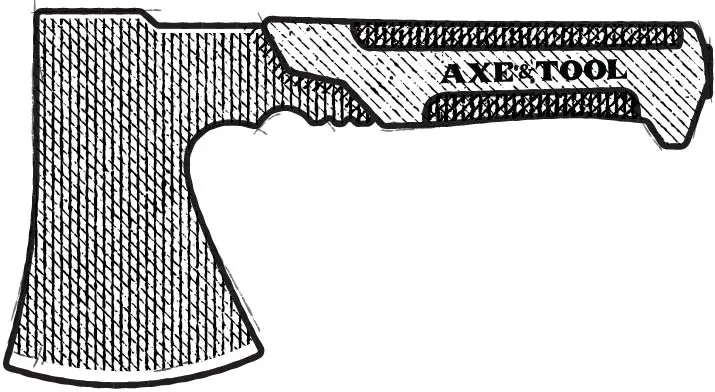
Ultralight Pack Hatchets are designed for backpackers and hikers to carry on long hikes when weight is a priority. They are made with a single slim piece of steel about 0.2″ wide, with scales added to the handle like a knife.
I don’t recommend these “axes” as they are really just axe-shaped knives. Proper hand hatchets are only slightly heavier and perform WAY better. Check out my head-on testing.
Undercutter Axe
AKA: Chainsaw Axe

The Undercutter was used by loggers on the West Coast from the 1930s to the early 1950s who were felling trees with early chainsaws. They were designed for clearing the face cuts with a long blade for chopping deep and a narrow chisel bit on the back for clearing chips between chainsaw cuts.
Early chainsaws were big, cumbersome, and could only cut horizontally when felling. So a series of cuts would be made getting progressively deeper as the saw moved up. Then the Undercutter axe could be used to break apart and clear these sections, creating an angled face cut for felling the tree.
This design was invented by the Walters Axe Company out of Quebec but was produced by American companies as well.
Undercutters sometimes get misidentified as the much more common Pulaski, which has a similar but wider mattock bit on the back.
V
Viking Axe

A Viking axe is a popular name for a stylized bearded axe. They have a long blade that drops down below the rest of the head, creating the “beard.” The extended blade creates a gap behind the cutting edge that allows for various grips for precise tasks. Most “Viking style” axes today are purely decorative.
W
Wedge Banger

A “wedge banger” axe is primarily used to fall trees by hammering wedges into a chainsaw cut. It has a heavy single-bit head with a flat poll on a short-to-midsize straight handle. These axes are often made with Dayton or Rafting pattern heads on 21″-24″ straight handles.
Wheelwright’s Axe
AKA: Wheeler’s Axe

A Wheelwright’s axe was used by carriage wheel makers (wheelwrights) to rough-cut the wooden slats used to form the body of a carriage wheel. Wheelwrights appear to have also used Coachmaker’s side axes and Cooper’s axes for this role.
Work Axe

The term “work axe” refers to a full-size or mid-size single-bit axe used as a general-purpose axe for both chopping and splitting tasks at home or the work camp.
Please comment below If I missed something or if you have any questions. I do my best to respond to everyone.
About the author:
About the author:
Jim Bell | Site Creator
I’m just a guy who likes axes. I got tired of only finding crap websites, so I set out to build a better one myself.
I’m also on Instagram: @axeandtool
Sources
- Yesteryearstools – Glossary of terms
- “Axe Makers of North America” by Allan Klenman (second edition – editor: Larry McPhail), 1990
- Blade Forums – Butcher’s Axe
- Vintage Tool Shop
- Exploring Axe History – Turpentine Axe
- Wikipedia
– Nessmuk
– Shepherd’s Axe - Journal of Light Construction – Rigger’s Axe
- Firefighting Canada
- Whiskey River Trading – Miner’s Track Hatchet
- Hans Bruner Tools
– Tree Poisoning Axe
– Coal Miner’s Axe
– Wheelwright’s Axe
– Coach Maker’s Axe
– Bridge Builder’s Axe - Boardingaxe.com
- Europeana.eu – butcher pole axe


Had you considered the froe axe?
I did think about it, but I felt it was ultimately not an axe. Similarly I left out the Adze. Might reconsider the Froe though. Thanks for the comment
Thank you for replying. I can see the line of reasoning, and that makes sense.